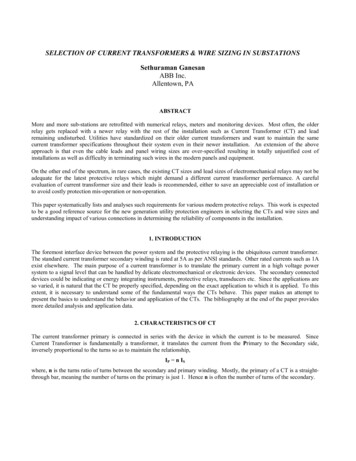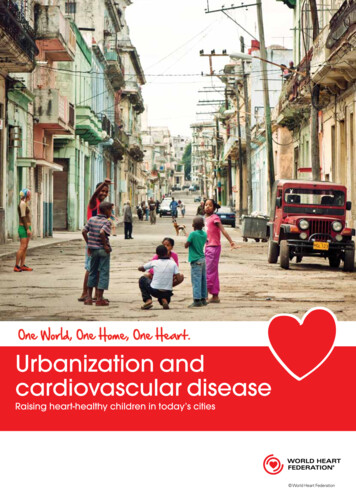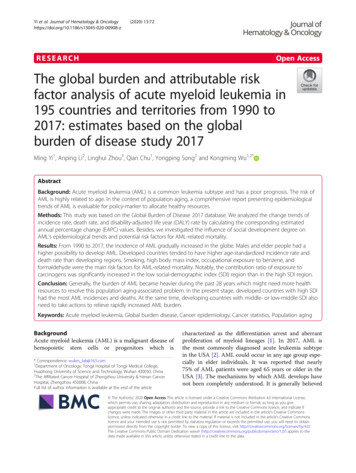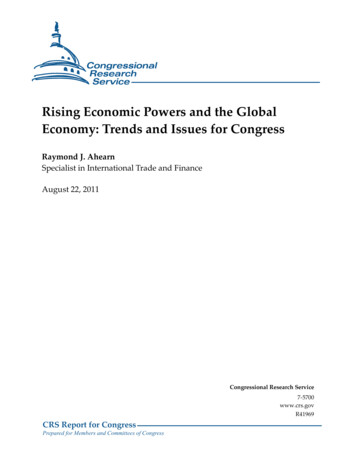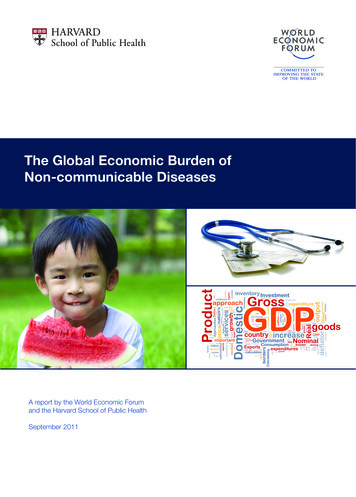
Transcription
The Global Economic Burden ofNon-communicable DiseasesA report by the World Economic Forumand the Harvard School of Public HealthSeptember 2011
Suggested citation: Bloom, D.E., Cafiero, E.T., Jané-Llopis, E., Abrahams-Gessel, S., Bloom, L.R., Fathima, S., Feigl,A.B., Gaziano, T., Mowafi, M., Pandya, A., Prettner, K., Rosenberg, L., Seligman, B., Stein, A., & Weinstein, C. (2011).The Global Economic Burden of Non-communicable Diseases. Geneva: World Economic Forum.See www.weforum.org/EconomicsOfNCDSee online appendix for detailed notes on the data sources and methods: www.weforum.org/EconomicsOfNCDappendixThe views expressed in this publication are those of the authorsalone. They do not necessarily represent the decisions, policy orviews of the World Economic Forum or the Harvard School ofPublic Health.World Economic Forum91-93 route de la CapiteCH-1223 Cologny/GenevaSwitzerlandTel.: 41 (0)22 869 1212Fax: 41 (0)22 786 2744E-mail: contact@weforum.orgwww.weforum.org 2011 World Economic ForumAll rights reserved.This material may be copied, photocopied, duplicated and sharedprovided that it is clearly attributed to the World Economic Forum.This material may not be used for commercial purposes.REF: 080911
Table of ContentsPreface5Executive Summary61. Background on NCDs72. The Global Economic Burden of NCDs142.1 Approach 1: Cost-of-Illness152.2 Approach 2: Value of Lost Output282.3 Approach 3: Value of a Statistical Life313. Conclusion35References38List of Tables42List of Figures43List of Boxes44Acknowledgements453
PrefaceNon-communicable diseases have been established as a clear threat not only to human health, but also to developmentand economic growth. Claiming 63% of all deaths, these diseases are currently the world’s main killer. Eighty percentof these deaths now occur in low- and middle-income countries. Half of those who die of chronic non-communicablediseases are in the prime of their productive years, and thus, the disability imposed and the lives lost are also endangeringindustry competitiveness across borders.Recognizing that building a solid economic argument is ever more crucial in times of financial crisis, this report brings tothe global debate fundamental evidence which had previously been missing: an account of the overall costs of NCDs,including what specific impact NCDs might have on economic growth.The evidence gathered is compelling. Over the next 20 years, NCDs will cost more than US 30 trillion, representing 48%of global GDP in 2010, and pushing millions of people below the poverty line. Mental health conditions alone will accountfor the loss of an additional US 16.1 trillion over this time span, with dramatic impact on productivity and quality of life.By contrast, mounting evidence highlights how millions of deaths can be averted and economic losses reduced by billionsof dollars if added focus is put on prevention. A recent World Health Organization report underlines that population-basedmeasures for reducing tobacco and harmful alcohol use, as well as unhealthy diet and physical inactivity, are estimatedto cost US 2 billion per year for all low- and middle-income countries, which in fact translates to less than US 0.40 perperson.The rise in the prevalence and significance of NCDs is the result of complex interaction between health, economic growthand development, and it is strongly associated with universal trends such as ageing of the global population, rapidunplanned urbanization and the globalization of unhealthy lifestyles. In addition to the tremendous demands that thesediseases place on social welfare and health systems, they also cause decreased productivity in the workplace, prolongeddisability and diminished resources within families.The results are unequivocal: a unified front is needed to turn the tide on NCDs. Governments, but also civil society andthe private sector must commit to the highest level of engagement in combatting these diseases and their rising economicburden. Global business leaders are acutely aware of the problems posed by NCDs. A survey of business executives fromaround the world, conducted by the World Economic Forum since 2009, identified NCDs as one of the leading threatsto global economic growth. Therefore, it is also important for the private sector to have a strategic vision on how to fulfillits role as a key agent for change and how to facilitate the adoption of healthier lifestyles not only by consumers, but alsoby employees. The need to create a global vision and a common understanding of the action required by all sectors andstakeholders in society has reached top priority on the global agenda this year, with the United Nations General Assemblyconvening a High-Level Meeting on the prevention and control of NCDs.If the challenges imposed on countries, communities and individuals by NCDs are to be met effectively this decade, theyneed to be addressed by a strong multistakeholder and cross-sectoral response, meaningful changes and adequateresources. We are pleased and proud to present this report, which we believe will strengthen the economic case foraction.Klaus SchwabFounder and Executive ChairmanWorld Economic ForumJulio FrenkDeanHarvard School of Public Health5
Executive SummaryAs policy-makers search for ways to reduce poverty and income inequality, and to achieve sustainable income growth,they are being encouraged to focus on an emerging challenge to health, well-being and development: non-communicablediseases (NCDs).After all, 63% of all deaths worldwide currently stem from NCDs – chiefly cardiovascular diseases, cancers, chronicrespiratory diseases and diabetes. These deaths are distributed widely among the world’s population – from highincome to low-income countries and from young to old (about one-quarter of all NCD deaths occur below the age of 60,amounting to approximately 9 million deaths per year). NCDs have a large impact, undercutting productivity and boostinghealthcare outlays. Moreover, the number of people affected by NCDs is expected to rise substantially in the comingdecades, reflecting an ageing and increasing global population.With this in mind, the United Nations is holding its first High-Level Meeting on NCDs on 19-20 September 2011 – thisis only the second time that a high-level UN meeting is being dedicated to a health topic (the first time being on HIV/AIDS in 2001). Over the years, much work has been done estimating the human toll of NCDs, but work on estimating theeconomic toll is far less advanced.In this report, the World Economic Forum and the Harvard School of Public Health try to inform and stimulate furtherdebate by developing new estimates of the global economic burden of NCDs in 2010, and projecting the size of theburden through 2030. Three distinct approaches are used to compute the economic burden: (1) the standard cost ofillness method; (2) macroeconomic simulation and (3) the value of a statistical life. This report includes not only the fourmajor NCDs (the focus of the UN meeting), but also mental illness, which is a major contributor to the burden of diseaseworldwide. This evaluation takes place in the context of enormous global health spending, serious concerns about alreadystrained public finances and worries about lacklustre economic growth. The report also tries to capture the thinking of thebusiness community about the impact of NCDs on their enterprises.Five key messages emerge:s First, NCDs already pose a substantial economic burden and this burden will evolve into a staggering one over thenext two decades. For example, with respect to cardiovascular disease, chronic respiratory disease, cancer, diabetesand mental health, the macroeconomic simulations suggest a cumulative output loss of US 47 trillion over the nexttwo decades. This loss represents 75% of global GDP in 2010 (US 63 trillion). It also represents enough money toeradicate two dollar-a-day poverty among the 2.5 billion people in that state for more than half a century.s Second, although high-income countries currently bear the biggest economic burden of NCDs, the developing world,especially middle-income countries, is expected to assume an ever larger share as their economies and populationsgrow.s Third, cardiovascular disease and mental health conditions are the dominant contributors to the global economicburden of NCDs.s Fourth, NCDs are front and centre on business leaders’ radar. The World Economic Forum’s annual Executive OpinionSurvey (EOS), which feeds into its Global Competitiveness Report, shows that about half of all business leaderssurveyed worry that at least one NCD will hurt their company’s bottom line in the next five years, with similarly highlevels of concern in low-, middle- and high-income countries – especially in countries where the quality of healthcare oraccess to healthcare is perceived to be poor. These NCD-driven concerns are markedly higher than those reported forthe communicable diseases of HIV/AIDS, malaria and tuberculosis.s Fifth, the good news is that there appear to be numerous options available to prevent and control NCDs. For example,the WHO has identified a set of interventions they call “Best Buys” There is also considerable scope for the design andimplementation of programmes aimed at behaviour change among youth and adolescents, and more cost-effectivemodels of care – models that reduce the care-taking burden that falls on untrained family members. Further researchon the benefits of such interventions in relation to their costs is much needed.It is our hope is that this report informs the resource allocation decisions of the world’s economic leaders – topgovernment officials, including finance ministers and their economic advisors – who control large amounts of spending atthe national level and have the power to react to the formidable economic threat posed by NCDs.6
1. Background on NCDsNon-communicable diseases (NCDs) impose a large burden on human health worldwide. Currently, more than 60% of alldeaths worldwide stem from NCDs (Figure 1). Moreover, what were once considered “diseases of affluence” have nowencroached on developing countries. In 2008, roughly four out of five NCD deaths occurred in low- and middle-incomecountries (WHO, 2011a), up sharply from just under 40% in 1990 (Murray & Lopez, 1997). Moreover, NCDs are having aneffect throughout the age distribution – already, one-quarter of all NCD-related deaths are among people below the age of60 (WHO, 2011a). NCDs also account for 48% of the healthy life years lost (Disability Adjusted Life Years–DALYs)1worldwide (versus 40% for communicable diseases, maternal and perinatal conditions and nutritional deficiencies, and1% for injuries) (WHO 2005a ).Figure 1: NCDs constitute more than 60% of deaths worldwide* “Other conditions” comprises communicable diseases, maternal and perinatal conditions and nutritional deficiencies.Data are for 2005. Source: (WHO, 2005a)Adding urgency to the NCD debate is the likelihood that the number of people affected by NCDs will rise substantiallyin the coming decades. One reason is the interaction between two major demographic trends. World population isincreasing, and although the rate of increase has slowed, UN projections indicate that there will be approximately 2 billionmore people by 2050. In addition, the share of those aged 60 and older has begun to increase and is expected to growvery rapidly in the coming years (see Figure 2). Since NCDs disproportionately affect this age group, the incidence of thesediseases can be expected to accelerate in the future. Increasing prevalence of the key risk factors will also contribute tothe urgency, particularly as globalization and urbanization take greater hold in the developing world.Figure 2: The world population is growing and getting olderSource: (United Nations Population Division, 2011)The World Health Organization defines DALYs (Disability Adjusted Life Years) as “The sum of years of potential life lost due to premature mortality and theyears of productive life lost due to disability.”(World Health Organization, 2011b) A DALY is a healthy life year lost.17
In light of the seriousness of these diseases, both in human and financial terms, the United Nations is holding its firstHigh-Level Meeting on NCDs on 19-20 September 2011. This is only the second time that the UN General Assemblyis dedicating a high-level meeting to a health issue (the first time being on HIV/AIDS in 2001). Meanwhile, countriesare developing strategies and guidelines for addressing NCDs and risk factors through innovative changes to healthinfrastructure, new funding mechanisms, improved surveillance methods and policy responses (WHO, 2011a). Yet thereality is that these approaches as they stand today are severely inadequate.Defining NCDsWhat exactly are NCDs?2,3 They are defined as diseases of long duration, generally slow progression and they are themajor cause of adult mortality and morbidity worldwide (WHO, 2005a ). Four main diseases are generally considered to bedominant in NCD mortality and morbidity: cardiovascular diseases (including heart disease and stroke), diabetes, cancerand chronic respiratory diseases (including chronic obstructive pulmonary disease and asthma) (see Box 1).The High-Level Meeting will focus on the four main diseases, but it is important to bear in mind that they do not make upa comprehensive list. A key set of diseases not included on the list are mental illnesses – including unipolar depressivedisorder, alcohol use disorders and schizophrenia all major contributors to the economic losses stemming from NCDs.Also excluded are sense disorders such as glaucoma and hearing loss, digestive diseases such as cirrhosis, andmusculoskeletal diseases such as rheumatoid arthritis and gout. These conditions impose private and social costs thatare also likely to be substantial. For example, musculoskeletal diseases can severely diminish one’s capacity to undertakemanual labour, such as farming, which is the dominant productive activity in rural settings that are home to 50% of theworld’s population.Moreover, the term NCD is something of a misnomer because it encompasses some diseases that are infectious inorigin. Human papillomavirus is a cause of various cancers (for example, cervical, anal, genital and oral) and a portion ofgastric cancers are caused by the H. pylori bacteria. Indeed, up to one in five cancers is said to be caused by infection.In the social sphere, NCD risks are also shared – eating, drinking and smoking habits are powerfully influenced by socialnetworks.Box 1: A snapshot of the five major NCDsCardiovascular disease (CVD) refers to a group of diseases involving the heart, blood vessels, or the sequelae ofpoor blood supply due to a diseased vascular supply. Over 82% of the mortality burden is caused by ischaemic orcoronary heart disease (IHD), stroke (both hemorrhagic and ischaemic), hypertensive heart disease or congestive heartfailure (CHF). Over the past decade, CVD has become the single largest cause of death worldwide, representing nearly30% of all deaths and about 50% of NCD deaths (WHO, 2011a). In 2008, CVD caused an estimated 17 million deathsand led to 151 million DALYs (representing 10% of all DALYs in that year). Behavioural risk factors such as physicalinactivity, tobacco use and unhealthy diet explain nearly 80% of the CVD burden (Gaziano, Bitton, Anand, AbrahamsGessel & Murphy, 2010).Cancer refers to the rapid growth and division of abnormal cells in a part of the body. These cells outlive normal cellsand have the ability to metastasize, or invade parts of the body and spread to other organs. There are more than 100types of cancers, and different risk factors contribute to the development of cancers in different sites. Cancer is thesecond largest cause of death worldwide, representing about 13% of all deaths (7.6 million deaths). Recent literatureestimated the number of new cancer cases in 2009 alone at 12.9 million, and this number is projected to rise to nearly17 million by 2020. (Beaulieu N, Bloom DE, Reddy Bloom L, & Stein RM, 2009).Chronic respiratory diseases refer to chronic diseases of the airways and other structures of the lung. Some of themost common are asthma, chronic obstructive pulmonary disease (COPD), respiratory allergies, occupational lungdiseases and pulmonary hypertension, which together account for 7% of all deaths worldwide (4.2 million deaths).COPD refers to a group of progressive lung diseases that make it difficult to breathe – including chronic bronchitis andemphysema (assessed by pulmonary function and x-ray evidence). Affecting more than 210 million people worldwide,COPD accounts for 3-8% of total deaths in high-income countries and 4-9% of total deaths in low- and middle-incomecountries (LMICs) (Mannino et al., 2007).The World Health Organization (WHO) refers to these conditions as “chronic diseases.” For more information, see (WHO 2005a)Non-communicable diseases are identified by WHO as “Group II Diseases,” a category that aggregates (based on ICD-10 code) the following conditions/causesof death: Malignant neoplasms, other neoplasms, diabetes mellitus, endocrine disorders, neuropsychiatric conditions, sense organ diseases, cardiovasculardiseases, respiratory diseases (e.g. COPD, asthma, other), digestive diseases, genitourinary diseases, skin diseases, musculoskeletal diseases (e.g. rheumatoidarthritis), congenital anomalies (e.g. cleft palate, down syndrome), and oral conditions (e.g. dental caries). These are distinguished from Group I diseases(communicable, maternal, perinatal and nutritional conditions) and Group III diseases (unintentional and intentional injuries).238
Diabetes is a metabolic disorder in which the body is unable to appropriately regulate the level of sugar, specificallyglucose, in the blood. Diabetes causes poor regulation of glucose in the blood, either by poor sensitivity to the proteininsulin, or due to inadequate production of insulin by the pancreas. Type 2 diabetes accounts for 90-95% of all diabetescases. Diabetes itself is not a high-mortality condition (1.3 million deaths globally), but it is a major risk factor for othercauses of death and has a high attributable burden of disability. Diabetes is also a major risk factor for cardiovasculardisease, kidney disease and blindness.Mental illness is a term that refers to a set of medical conditions that affect a person’s thinking, feeling, mood,ability to relate to others and daily functioning. Sometimes referred to as mental disorders, mental health conditionsor neuropsychiatric disorders, these conditions affect hundreds of millions of people worldwide. In 2002, 154million people suffered from depression globally, 25 million people from schizophrenia and over 100 million peoplesuffered from alcohol or drug abuse disorders (WHO 2011a). Close to 900,000 people die from suicide each year.Neuropsychiatric conditions are also a substantial contributor to DALYs, contributing 13% of all DALYs in 2004 (WHO,2005b).Major NCD risk factorsNCDs stem from a combination of modifiable and non-modifiable risk factors.Non-modifiable risk factors refer to characteristics that cannot be changed by an individual (or the environment) andinclude age, sex, and genetic make-up. Although they cannot be the primary targets of interventions, they remainimportant factors since they affect and partly determine the effectiveness of many prevention and treatment approaches.A country’s age structure may convey important information on the most prevalent diseases, as may the population’sracial/ethnic distribution.Modifiable risk factors refer to characteristics that societies or individuals can change to improve health outcomes. WHOtypically refers to four major ones for NCDs: poor diet, physical inactivity, tobacco use, and harmful alcohol use (WHO,2011a).Poor diet and physical inactivity. The composition of human diets has changed considerably over time, withglobalization and urbanization making processed foods high in refined starch, sugar, salt and unhealthy fats cheaplyand readily available and enticing to consumers – often more so than natural foods (Hawkes, 2006; Kennedy, Nantel, &Shetty, 2004; Lieberman, 2003; WHO, 2002). As a result, overweight and obesity, and associated health problems, areon the rise in the developing world (Cecchini, et al., 2010). Exacerbating matters has been a shift toward more sedentarylifestyles, which has accompanied economic growth, the shift from agricultural economies to service-based economies,and urbanization in the developing world. This spreading of the fast food culture, sedentary lifestyle and increase inbodyweight has led some to coin the emerging threat a “globesity” epidemic (Bifulco & Caruso, 2007; Deitel, 2002;Schwartz, 2005).Tobacco. High rates of tobacco use are projected to lead to a doubling of the number of tobacco-related deathsbetween 2010 and 2030 in low- and middle-income countries. Unless stronger action is taken now, the 3.4 milliontobacco-related deaths today will become 6.8 million in 2030 (NCD Alliance, 2011). A 2004 study by the Food andAgriculture Organization (FAO) predicted that developing countries would consume 71% of the world’s tobacco in2010 (FAO, 2004). China is a global tobacco hotspot, with more than 320 million smokers and approximately 35% ofthe world’s tobacco production (FAO, 2004; Global Adult Tobacco Survey - China Section, 2010). Tobacco accountsfor 30% of cancers globally, and the annual economic burden of tobacco-related illnesses exceeds total annual healthexpenditures in low- and middle-income countries (American Cancer Society & World Lung Foundation, 2011).Alcohol. Alcohol use has been causally linked to many cancers and in excessive quantity with many types ofcardiovascular disease (Boffetta & Hashibe, 2006; Ronksley, Brien, Turner, Mukamal, & Ghali, 2011). Alcohol accountedfor 3.8% of deaths and 4.6% of DALYs in 2004 (GAPA, 2011). Evidence also shows a causal, dose-response relationshipbetween alcohol use and several cancer sites, including the oral cavity, pharynx, larynx, oesophagus, liver and femalebreast (Rehm, et al., 2010).4Although low to moderate alcohol use (less than 20g per day) has been linked to some advantageous cardiovascular outcomes (particularly ischaemic heartdisease and strokes), heavy chronic drinking has been linked to adverse cardiovascular outcomes. The detrimental effects of heavy drinking have been shown tooutweigh its benefits by two- to three-fold based on cost-benefit calculations of lives saved or improved versus lives lost or disabled (Parry & Rehm, 2011).49
The pathway from modifiable risk factors to NCDs often operates through what are known as “intermediate risk factors”– which include overweight/obesity, elevated blood glucose, high blood pressure and high cholesterol. Secondaryprevention measures can tackle most of these risk factors, such as changes in diet or physical activity or the use ofmedicines to control blood pressure and cholesterol, oral agents or insulin to control blood sugar and pharmacological/surgical means to control obesity.Although intervening on intermediate risk factors may be more effective (and more cost-effective) than waiting untilNCDs have fully developed, treating intermediate risk factors may, in turn, be less effective (and less cost-effective) thanprimary prevention measures or creating favorable social and policy environments to reduce vulnerability to developingdisease (Brownell & Frieden, 2009; National Commission on Prevention Priorities, 2007; Satcher, 2006; Woolf, 2009).After all, even those with the will to engage in healthy practices may find it difficult to do so because they live or workin environments that restrict their ability to make healthy choices. For these reasons, the need to address socialdeterminants of NCDs was reiterated at the 64th World Health Assembly held in Geneva, Switzerland in May 2011 byWHO Member States in preparation for the UN High-Level Meeting in September 2011.Macro-level contextual factors include the built and social environment; political, economic and legal systems; the policyenvironment; culture; and education. Social determinants are often influenced by political systems, whose operation leadsto important decisions about the resources dedicated to health in a given country. For example, in the United States, freemarket systems often promote an individualistic cultural and social environment – which affects the amount of resourcesallocated for healthcare, how these resources are spent and the balance of state versus out-of-pocket expenditures thatare committed to protect against, and cope with, the impact of disease (Kaiser, 2010; Siddiqi, Zuberi, & Nguyen, 2009).Political systems that promote strong social safety nets tend to have fewer social inequalities in health (Beckfield & Krieger,2009; Navarro & Shi, 2001).Social structure is also inextricably linked with economic wealth, with the poor relying more heavily on social supportthrough non-financial exchanges with neighbours, family and friends to protect against, and cope with, the impact ofdisease. Wilkinson and Marmot have written extensively on the role that practical, financial and emotional support plays inbuoying individuals in times of crisis, and the positive impact this can have on multiple health outcomes including chronicdisease (Wilkinson & Marmot, 2003).The United Nations Population Fund (UNFPA) reports that the proportion of the world’s population living in urban areassurpassed half in 2008. The United Nations Human Settlements Programme (UN-HABITAT) estimates that by 2050, twothirds of people around the world will live in urban areas. Approximately 1 billion people live in urban slums. According tothe UN, 6.5% of cities are made up of slums in the developed world, while in the developing world the figure is over 78%.Although most studies note an economic “urban advantage” for those living in cities because of greater access to servicesand jobs, this advantage is often diminished by the higher cost of living in cities and low quality of living conditions inurban slums (ECOSOC, 2010).In addition, urbanization and globalization heavily influence resource distribution within societies, often exacerbatinggeographic and socioeconomic inequalities in health (Hope, 1989; Schuftan, 1999). Notably, a 100-country studyby Ezzati et al. found that both body mass index (BMI) and cholesterol levels were positively associated with a rise inurbanization and national income (Ezzati, et al., 2005). At a regional level, a study conducted by Allender et al. similarlyfound strong links between the proportion of people living in urban areas and NCD risk factors in the state of Tamil Nadu,India (Allender, et al., 2010). This study observed a positive association between urbanicity and smoking, BMI, bloodpressure and low physical activity among men. Among women, urban concentration was positively associated with BMIand low physical activity. Similar findings have been observed in other countries as well (Vlahov & Galea, 2002). A growingliterature has emerged on the effect of the built environment and global trends toward urbanization on health (Michael, etal., 2009).Education matters, too. This effect is at least partially attributable to the better health literacy that results from eachadditional year of formal education. Improved health literacy has been linked to improved outcomes in breastfeeding,reduction in smoking and improved diets and lowered cholesterol levels (ECOSOC, 2010).10
Income also matters. The evidence indicates a dynamic relationship between socioeconomic status (SES) and health,mediated by a country’s income level (Braveman PA, 2005). In less developed countries, there tends to be a positiveassociation between SES and obesity. But as a country’s GDP increases, this association changes to a negative one(McLaren, 2007). In other words, in poorer countries, higher SES groups tend to be at greater risk of developing obesityrelated NCDs, whereas in wealthier countries, lower SES groups tend to be a greater risk (Monteiro, Moura, Conde, &Popkin, 2004). Thus, it is important to develop country-specific programmes to address these varied dynamics and toensure that strategies are integrated into other country-level social policies to meet health and development goals.Further, distinguishing the risk of developing disease from the risk of disease mortality will be critical when making policydecisions regarding the costs and benefits of particular interventions. While the wealthy may be more likely to acquireNCDs in low- and middle-income countries, the poor are much more likely to die from them because they lack theresources to manage living with disease. NCDs are also more likely to go undetected in poor populations, resulting in evengreater morbidity, diminished quality of life and lost productivity. At a population level, this dynamic can result in a diseasepoverty trap, in which overall workforce quantity and quality is compromised owing to individuals being pushed out by theburden of disease. This can diminish a country’s economic output and hinder its pace of economic growth.Anticipated global economic impactAlthough research on the global economic effects of non-communicable diseases is still in a nascent stage, economistsare increasingly expressing concern that NCDs will result in long-term macroeconomic impacts on labour supply, capitalaccumulation and GDP worldwide with the consequences most severe in developing countries (D. Abegunde & Stanciole,2006; D. O. Abegunde, Mathers, Adam, Ortegon, & Strong, 2007; Foulkes, 2011; Nikolic, Stanciole, & Zaydman, 2011;Suhrcke, Stuckler, & Rocco, 2006).5Globally, the labour units lost owing to NCD deaths and the direct medical costs of treating NCDs have reduced thequality and quantity of the labour force and human capital (Mayer-
In this report, the World Economic Forum and the Harvard School of Public Health try to inform and stimulate further debate by developing new estimates of the global economic burden of NCDs in 2010, and projecting the size of the burden through 2030. Three distinct approaches are used to compute the economic burden: (1) the standard cost of




